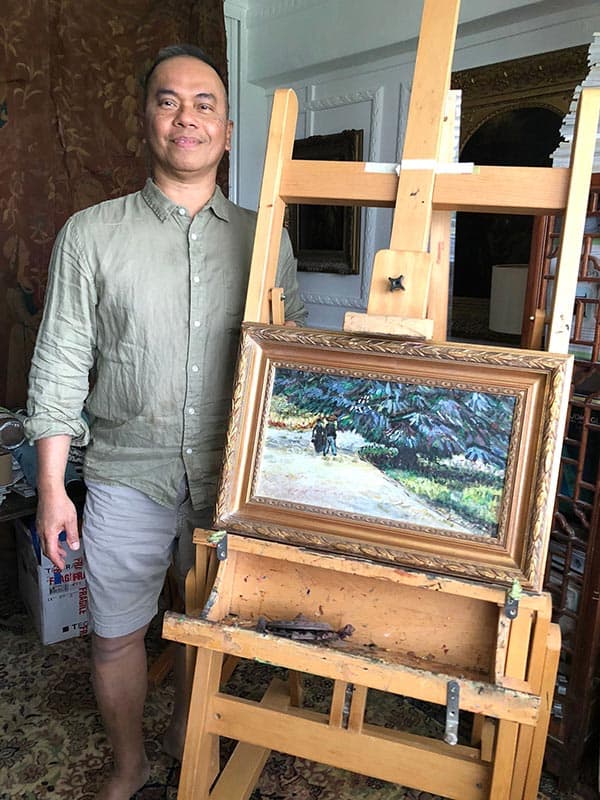There’s an HDB flat near Bedok Reservoir that looks nothing like any other HDB flat we’ve ever seen. (For our non-Singapore based friends, HDB refers to the Housing Development Board, or the government agency which plans and develops public housing in Singapore.) While there are many well-designed HDB homes out there, we’d hazard a guess that none are quite as special as artist Johann M. Fauzi’s, whose flat doubles up as his art studio.
From the outside, the apartment looks nondescript.

When the door swings open though, you’ll find yourself stepping into another world, as Johann’s tricked out his flat to resemble a European Renaissance parlour.



If these images seem familiar at all, you might realise that Johann’s studio has been extensively featured in fashion shoots and articles on interior design, while also being open to personal friends and art school interns.
While his art practice includes mediums such as painting, it is his interventions into installation work that have propelled him more firmly into the public eye. In a show at Comma Space, his work Jemputan (or “Invitation”) turned a gallery space into a faux-colonial fantasy played out in the context of a participatory meal. In Nanyang Technological University School of Art, Design & Media’s exhibition The Foot Beneath the Flower, his 2020 installation Emancipation involved a re-creation of Dutch artist Joachim Wtewael’s 17th century painting The Martyrdom of Saint Sebastian.

While Johann’s works are intricately made and sumptuous to behold in their over-the-top splendour, the stories behind them are just as interesting, as they interrogate the artist’s own place as a self-professed Anglophile art collector hailing from a conservative Malay-Javanese family based in Singapore. His own sculptures and paintings are heavily influenced by the classical styles that he loves and collects, and he displays an almost fanatic preoccupation with the details of excellent craftsmanship, something that he thinks that artists should not overlook, even as they make explorations into the realm of the conceptual.
Just as colonial-era travellers once collected artistic treasures from ‘exotic’ far-flung regions, Johann has himself – in a sort of satirical inversion – gathered antiques of his own from the distant lands of colonisers, for the purposes of display in an HDB flat in Singapore.
On the day that I visit him, I find that the space is dark, and almost a little gloomy but for scattered pools of yellow light emanating from vintage lamps. “The antiques need to be protected from harsh light,” Johann explains.

Still, there is a warmth in this studio space that extends well beyond its intricate and expensive interiors, one that can be attributed fully to the hospitable artist that resides and works here. Art world insiders in Singapore will be familiar with Johann’s afternoon soirees, well-documented on his social media feeds – food is always abundant, and laughter aplenty. My visit is no different, as I am welcomed with a ‘light lunch’ of a delicious lobster and prawn salad with a homemade tomato salsa.


A soundtrack of opera accompanies the meal. Everything is laid out beautifully and with the curtains in the apartment drawn shut, I feel like I have stepped into an immersive alternate reality.
It’s an effect that is important to Johann.
He explains, “I want people, when they visit, to lose themselves, to escape into my work. My world (in this flat) is a conceptual framing of the 18th century, and when my guests step into it, they forget the outside world. When my friends come over I want them to feel relaxed, I don’t even care that much if the antiques crack or break.”

Johann is himself an enigma. He refuses to publicly reveal his age but snippets of conversation reveal a colourful and varied past, one that hints of a personal history that stretches much further back than his youthful looks might indicate. He speaks of working in his previous profession in sales and marketing, in the paper manufacturing industry, and alludes to working all over the world, including in “Vietnam when it was still very communist.”
His story starts however, with the typical narrative of someone growing up in a dense, hyper-capitalistic urban environment. As a young child he was talented and interested in art, but was told by his parents that artistic pursuits would not make him money and that he would “remain poor” if he stuck with them.

While his parents were unwilling to sponsor his artistic studies, a young Johann eventually found himself in university in Australia where he was able to easily immerse himself in museum culture and develop his love for beautifully decorated interiors.
“Even in uni,” he chuckles, “my dorm was in this 19th century building and I decorated my entire room in Laura Ashley, doing all kinds of part-time jobs like gardening, dishwashing and house-cleaning to pay for it. I would wait for the sales when the things were 70 to 80 per cent off. ”
He also offers young artists a perspective that is quite different from the usual YOLO-fueled advice to follow one’s passions without restraint. He explains that his journey as an artist involved many years of hard graft in a corporate career to “pay the bills.” He slowly squirrelled aside funds while juggling art classes in all mediums such as printmaking, ceramics and sculpture, in schools like the Nanyang Academy of Fine Arts to discover where his true artistic talents and leanings lay. While time-consuming in the midst of his work commitments, this duality was never pressurising as art was always something deeply enjoyable to him and a source of stress relief.
“It does not matter if you are good at something or not, what is most important is that you must love it. Because technique can be learned as long as you practice, practice, practice,” he muses.
As someone who’s lived a full life, and in Johann’s words, “been there, done that and bought the T-shirt,” there is less of a struggle now as a practicing artist, as he’s much more financially secure. Additionally, he feels that his artistic work now has a depth to it that might not have existed if he had not “lived a life” before.
Our conversation moves on from one pet Singaporean topic (i.e. money) to another, one which is closely connected with his antiques (i.e. ghost stories). I ask him if has ever felt any strange energy associated with his possessions and he tells me that he once acquired a Qing dynasty chair that had been used in a temple, possibly by a medium. “I look at beauty first,” he chuckles, “not at other things, but when I took that chair home, shadows would dance around it at night. When you look at a chair placed in one position, it may cast a shadow right? But for this chair, the shadows cast by it would move around. I was so scared, I brought it back to the antique shop immediately.”
Another work, a dark 19th century French painting of a woman in a lace dress, with “watery eyes,” gave him goosebumps. However, he felt that he had to have it because of the intricate detail in the lifelike skin tone of the woman’s face, which served as a good reference for his own painting.
“It hung by the main entrance of my house, and I would feel so scared to come back home,” he admits.
He finally dealt with the eeriness by speaking to the painting saying, “I don’t give a f*k, I am the owner now, so you listen to me.”
After that, there were no more spooky feelings, and the painting now sits quite happily by his bed.
The nosy Asian auntie in me cannot help but ask the (very rude) question of how expensive everything is and whether he has ever considered selling his flat together with his collection. Johann laughs and says that while no one has offered to buy his collection or his flat yet, he would certainly be open to selling them, so that he can “collect new things.”
“I am not a slave to any of these things,” explains, “you can touch them, and they are meant to be enjoyed.”
Almost instinctively – and I am a little ashamed at how quickly the next words trip off my tongue – I ask, “But if you sold your flat, and added that amount to the sales proceeds (from an antique sale), wouldn’t you be able to afford a bigger apartment, or a private condominium, or even a flat that’s in a more central location?”
Johann is frank in his appraisal of what it means to have such an extravagant space located in the midst of public housing.
“In life, wherever I live, I must enjoy myself and surround myself with beautiful things. I was like this even with my university dorm room. Just because you live in an HDB flat, doesn’t mean that it has to look drab. The HDB is affordable and this place is accessible, right next to the MRT. There’s no point living in a small shoebox property in a ‘better’ location, or in a private property, and not be able to afford to do it up in the way that you like. It doesn’t matter to me what people think, this is my world, and as long as I don’t owe anyone any money, I can live how I please.”
And perhaps that is what is so special about this place. Unlike so many things in our crowded little island nation (made even more crowded these days by pandemic travel restrictions), the design of Johann’s studio seems driven by nothing more than the pursuit of joy through beauty, technical mastery and aesthetic appreciation. It is complicated, because well, how would you make the maths work? The flat defies traditional property investment principles and reminds us that concepts like joy and peace of mind may not be well-reflected in hard indicia like ROI.
In the end, I find myself leaving this artist’s studio with a big smile on my face. In a world where the only constant thing seems to be unending change, it is good to know that some folks still have the creativity and guts to march solidly to their own beat.
___________________________________
Find out more about Johann MF via his Instagram.










